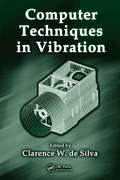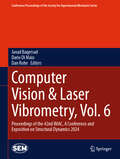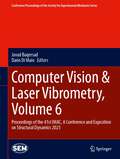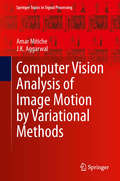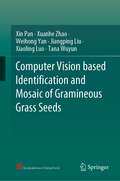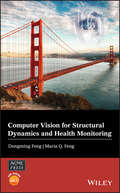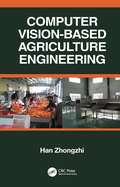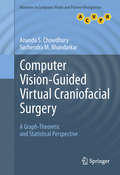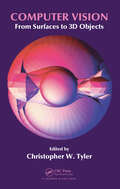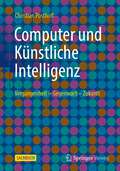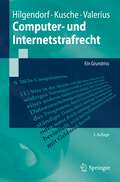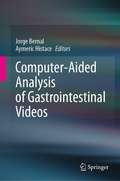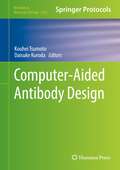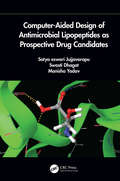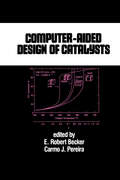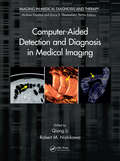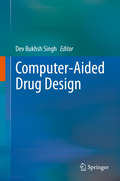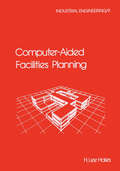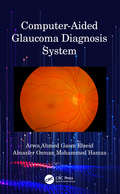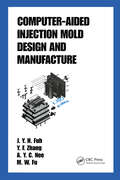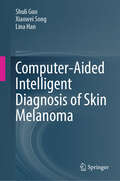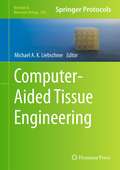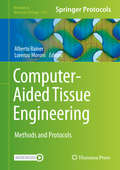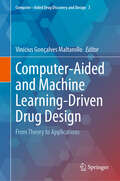- Table View
- List View
Computer Techniques in Vibration
by Clarence W. de SilvaUnderstanding and controlling vibration is critical for reducing noise, improving work environments and product quality, and increasing the useful life of industrial machinery and other mechanical systems. Computer-based modeling and analytical tools provide fast, accurate, and efficient means of designing and controlling a system for improved vibr
Computer Vision & Laser Vibrometry, Vol. 6: Proceedings of the 42nd IMAC, A Conference and Exposition on Structural Dynamics 2024 (Conference Proceedings of the Society for Experimental Mechanics Series)
by Dario Di Maio Javad Baqersad Dan RoheComputer Vision & Laser Vibrometry, Volume 6: Proceedings of the 42nd IMAC, A Conference and Exposition on Structural Dynamics, 2024, the sixth volume of ten from the Conference brings together contributions to this important area of research and engineering. The collection presents early findings and case studies on fundamental and applied aspects of Computer Vision, Laser Vibrometry and Structural Health Monitoring, including papers on: Novel Techniques Optical Methods, Scanning LDV Methods Photogrammetry & DIC Structural Health Monitoring
Computer Vision & Laser Vibrometry, Volume 6: Proceedings of the 41st IMAC, A Conference and Exposition on Structural Dynamics 2023 (Conference Proceedings of the Society for Experimental Mechanics Series)
by Dario Di Maio Javad BaqersadComputer Vision & Laser Vibrometry, Volume 6: Proceedings of the 41st IMAC, A Conference and Exposition on Structural Dynamics, 2023, the sixth volume of ten from the Conference brings together contributions to this important area of research and engineering. The collection presents early findings and case studies on fundamental and applied aspects of Computer Vision, Laser Vibrometry and Structural Health Monitoring, including papers on:Novel TechniquesOptical Methods,Scanning LDV MethodsPhotogrammetry & DICStructural Health Monitoring
Computer Vision Analysis of Image Motion by Variational Methods (Springer Topics in Signal Processing #10)
by Amar Mitiche J. K. AggarwalThis book presents a unified view of image motion analysis under the variational framework. Variational methods, rooted in physics and mechanics, but appearing in many other domains, such as statistics, control, and computer vision, address a problem from an optimization standpoint, i.e., they formulate it as the optimization of an objective function or functional. The methods of image motion analysis described in this book use the calculus of variations to minimize (or maximize) an objective functional which transcribes all of the constraints that characterize the desired motion variables. The book addresses the four core subjects of motion analysis: Motion estimation, detection, tracking, and three-dimensional interpretation. Each topic is covered in a dedicated chapter. The presentation is prefaced by an introductory chapter which discusses the purpose of motion analysis. Further, a chapter is included which gives the basic tools and formulae related to curvature, Euler Lagrange equations, unconstrained descent optimization, and level sets, that the variational image motion processing methods use repeatedly in the book.
Computer Vision based Identification and Mosaic of Gramineous Grass Seeds
by Xin Pan Xuanhe Zhao Weihong Yan Jiangping Liu Xiaoling Luo Tana WuyunThis book mainly deals with grassland digitalization and recognition through computer vision, which will make contributions to implement of grass auto recognition and data acquisition. Taking advantage of computer vision, it focuses on intrinsic feature extraction to realize the functions such as auto recognition of forage seeds and microscope images mosaic. The book presents a new approach for identification of grass seeds, with clear figures and detailed tables. It enlightens reader by solving the traditional problems of pratacultural science through the aid of computer science.
Computer Vision for Structural Dynamics and Health Monitoring (Wiley-ASME Press Series)
by Dongming Feng Maria Q. FengProvides comprehensive coverage of theory and hands-on implementation of computer vision-based sensors for structural health monitoring This book is the first to fill the gap between scientific research of computer vision and its practical applications for structural health monitoring (SHM). It provides a complete, state-of-the-art review of the collective experience that the SHM community has gained in recent years. It also extensively explores the potentials of the vision sensor as a fast and cost-effective tool for solving SHM problems based on both time and frequency domain analytics, broadening the application of emerging computer vision sensor technology in not only scientific research but also engineering practice. Computer Vision for Structural Dynamics and Health Monitoring presents fundamental knowledge, important issues, and practical techniques critical to successful development of vision-based sensors in detail, including robustness of template matching techniques for tracking targets; coordinate conversion methods for determining calibration factors to convert image pixel displacements to physical displacements; sensing by tracking artificial targets vs. natural targets; measurements in real time vs. by post-processing; and field measurement error sources and mitigation methods. The book also features a wide range of tests conducted in both controlled laboratory and complex field environments in order to evaluate the sensor accuracy and demonstrate the unique features and merits of computer vision-based structural displacement measurement. Offers comprehensive understanding of the principles and applications of computer vision for structural dynamics and health monitoring Helps broaden the application of the emerging computer vision sensor technology from scientific research to engineering practice such as field condition assessment of civil engineering structures and infrastructure systems Includes a wide range of laboratory and field testing examples, as well as practical techniques for field application Provides MATLAB code for most of the issues discussed including that of image processing, structural dynamics, and SHM applications Computer Vision for Structural Dynamics and Health Monitoring is ideal for graduate students, researchers, and practicing engineers who are interested in learning about this emerging sensor technology and advancing their applications in SHM and other engineering problems. It will also benefit those in civil and aerospace engineering, energy, and computer science.
Computer Vision-Based Agriculture Engineering
by Han ZhongzhiIn recent years, computer vision is a fast-growing technique of agricultural engineering, especially in quality detection of agricultural products and food safety testing. It can provide objective, rapid, non-contact and non-destructive methods by extracting quantitative information from digital images. Significant scientific and technological advances have been made in quality inspection, classification and evaluation of a wide range of food and agricultural products. Computer Vision-Based Agriculture Engineering focuses on these advances. The book contains 25 chapters covering computer vision, image processing, hyperspectral imaging and other related technologies in peanut aflatoxin, peanut and corn quality varieties, and carrot and potato quality, as well as pest and disease detection. Features: Discusses various detection methods in a variety of agricultural crops Each chapter includes materials and methods used, results and analysis, and discussion with conclusions Covers basic theory, technical methods and engineering cases Provides comprehensive coverage on methods of variety identification, quality detection and detection of key indicators of agricultural products safety Presents information on technology of artificial intelligence including deep learning and transfer learning Computer Vision-Based Agriculture Engineering is a summary of the author's work over the past 10 years. Professor Han has presented his most recent research results in all 25 chapters of this book. This unique work provides students, engineers and technologists working in research, development, and operations in agricultural engineering with critical, comprehensive and readily accessible information. It applies development of artificial intelligence theory and methods including depth learning and transfer learning to the field of agricultural engineering testing.
Computer Vision-Guided Virtual Craniofacial Surgery: A Graph-Theoretic and Statistical Perspective (Advances in Computer Vision and Pattern Recognition)
by Ananda S. Chowdhury Suchendra M. BhandarkarThis unique text/reference discusses in depth the two integral components of reconstructive surgery; fracture detection, and reconstruction from broken bone fragments. In addition to supporting its application-oriented viewpoint with detailed coverage of theoretical issues, the work incorporates useful algorithms and relevant concepts from both graph theory and statistics. Topics and features: presents practical solutions for virtual craniofacial reconstruction and computer-aided fracture detection; discusses issues of image registration, object reconstruction, combinatorial pattern matching, and detection of salient points and regions in an image; investigates the concepts of maximum-weight graph matching, maximum-cardinality minimum-weight matching for a bipartite graph, determination of minimum cut in a flow network, and construction of automorphs of a cycle graph; examines the techniques of Markov random fields, hierarchical Bayesian restoration, Gibbs sampling, and Bayesian inference.
Computer Vision: From Surfaces to 3D Objects
by Christopher W. TylerThe typical computational approach to object understanding derives shape information from the 2D outline of the objects. For complex object structures, however, such a planar approach cannot determine object shape; the structural edges have to be encoded in terms of their full 3D spatial configuration. Computer Vision: From Surfaces to 3D Objects i
Computer und Künstliche Intelligenz: Vergangenheit - Gegenwart - Zukunft
by Christian PosthoffDas Buch beginnt mit einer Erklärung der menschlichen Intelligenz und der Beschreibung von Intelligenztests. Die Künstliche Intelligenz, die auf Computerprogrammen beruht, beginnt mit der Dartmouth – Konferenz 1956, an der sich berühmte Informatiker dieser Zeit beteiligten. Diese damit eingeleitete Entwicklung wurde von großen Fortschritten der Kybernetik und der Spieltheorie begleitet.Es folgen Beschreibungen wichtiger Methoden und Anwendungen:Maschinelles Lernen und Neuronale Netze Sehr publikumswirksam waren die Entwicklungen von Programmen für strategische Spiele, die nach einem kurzen Training die jeweiligen Weltmeister besiegen konnten. Die Sprachübersetzer von Google und DeepL sind mittlerweile vielen bekannt. Es wird erklärt, wie intelligente Systeme mit Datenbanken zusammenarbeiten, wie beliebige Daten digitalisiert werden können. Große Mengen an Daten werden unter dem Stichwort „Big Data“ behandelt. Ausführlich beschrieben werden die Bildverarbeitung, die Erkennung von Tumoren und Viren. Robotik ist ein weiterer Punkt, der ausführlich dargestellt wird. Roboter in der Chirurgie und in der Pflege sind ebenfalls sehr bedeutsam. „Exotische Ausreißer“ sind die Anwendungen in der Kunst. Sehr bedeutsam für die zukünftige Entwicklung sind Anwendungen in der Rechtssprechung.
Computer- und Internetstrafrecht: Ein Grundriss (Springer-Lehrbuch)
by Brian Valerius Eric Hilgendorf Carsten KuscheDie Informations- und Kommunikationstechnologie stellt das Strafrecht vor die Aufgabe, sowohl klassische Delikte in ihrem neuen technisierten Gewand zu erfassen als auch ganz neuen Kriminalitätsformen zu begegnen. Das Lehrbuch vermittelt einen umfassenden Überblick über das Rechtsgebiet und zeigt die aktuellen Probleme auf. Die 2. Auflage berücksichtigt Entwicklungen in Gesetzgebung und Rechtsprechung und enthält ein neues Kapitel zu strafverfahrensrechtlichen Fragen im Zusammenhang mit Computern und Computernetzwerken.
Computer-Aided Analysis of Gastrointestinal Videos
by Jorge Bernal Aymeric HistaceThis book opens with an introduction to the main purpose and tasks of the GIANA challenge, as well as a summary and an analysis of the results and performance obtained by the 20 participating teams. The early and accurate diagnosis of gastrointestinal diseases is critical for increasing the chances of patient survival, and efficient screening is vital for locating precursor lesions. Video colonoscopy and wireless capsule endoscopy (WCE) are the gold-standard tools for colon and intestinal tract screening, respectively. Yet these tools still present some drawbacks, such as lesion miss rate, lack of in vivo diagnosis capabilities, and perforation risk. To mitigate these, computer-aided detection/diagnosis systems can play a key role in assisting clinicians in the different stages of the exploration.This book presents the latest, state-of-the-art approaches in this field, and also tackles the clinical considerations required to efficiently deploy these systems in the exploration room. The coverage draws upon results from the Gastrointestinal Image Analysis (GIANA) Challenge, part of the EndoVis satellite events of the conferences MICCAI 2017 and 2018. Each method proposed to address the different subtasks of the challenges is detailed in a separate chapter, offering a deep insight into this topic of interest for public health.This book appeals to researchers, practitioners, and lecturers spanning both the computer vision and gastroenterology communities.
Computer-Aided Antibody Design (Methods in Molecular Biology #2552)
by Kouhei Tsumoto Daisuke KurodaThis volume details state-of-the- art methods on computer-aided antibody design. Chapters guide readers through information on antibody sequences and structures, modeling antibody structures and dynamics, prediction and optimization of biological and biophysical properties of antibodies, prediction of antibody-antigen interactions, and computer-aided antibody affinity maturation and beyond. Written in the format of the highly successful Methods in Molecular Biology series, each chapter includes an introduction to the topic, lists necessary materials and reagents, includes tips on troubleshooting and known pitfalls, and step-by-step, readily reproducible protocols. Authoritative and cutting-edge, Computer-Aided Antibody Design aims to be a useful and practical guide to new researchers and experts looking to expand their knowledge. Chapter 2 is available open access under a Creative Commons Attribution 4.0 International License via link.springer.com.
Computer-Aided Design of Antimicrobial Lipopeptides as Prospective Drug Candidates
by Manisha Yadav Jujjvarapu Satya Eswari Swasti DhagatIncrease in antibiotic resistance has forced researchers to develop new drugs against microorganisms. Lipopeptides are produced as secondary metabolites by some microorganisms. Computer-aided Design of Antimicrobial Lipopeptides as Prospective Drug Candidates provides the identification of novel ligands for different antimicrobial lipopeptides. Along with identification, it also provides some of the in silico drug design processes, namely homology modelling, molecular docking, QSAR studies, drug ADMET studies and pharmacophore studies to check the ligand-lipopeptide interaction. Some lipopeptides have shown anti-cancerous properties too, and this book discusses the required templates to design new drugs using computational techniques. Key Features: Focuses on the use lipopeptides as new antimicrobial compounds Presents the basics of in silico modelling for design and development of new drug molecules, and is therefore of interest to beginners in the field Provides a step-by-step process for identification of drug molecules and testing its efficacy in silico Couples with courses on patents and intellectual property rights
Computer-Aided Design of Catalysts
by E. Robert Becker and Carmo J. PereiraThis volume provides an update on recent developments in computer-aided design and modeling of catalysts for a variety of important industrial applications. Key hurdles in catalyst design are different for each application: the modeling frontiers for methane partial oxidation, automotive catalysis,
Computer-Aided Detection and Diagnosis in Medical Imaging (Imaging in Medical Diagnosis and Therapy)
by Qiang Li Robert M. NishikawaImprove the Accurate Detection and Diagnosis of Cancer and Other DiseasesDespite the expansion of the CAD field in recent decades, there is currently no single book dedicated to the development and use of CAD systems. Filling this need, Computer-Aided Detection and Diagnosis in Medical Imaging covers the major technical advances and methodologies s
Computer-Aided Drug Design
by Dev Bukhsh SinghThis book provides up-to-date information on bioinformatics tools for the discovery and development of new drug molecules. It discusses a range of computational applications, including three-dimensional modeling of protein structures, protein-ligand docking, and molecular dynamics simulation of protein-ligand complexes for identifying desirable drug candidates. It also explores computational approaches for identifying potential drug targets and for pharmacophore modeling. Moreover, it presents structure- and ligand-based drug design tools to optimize known drugs and guide the design of new molecules. The book also describes methods for identifying small-molecule binding pockets in proteins, and summarizes the databases used to explore the essential properties of drugs, drug-like small molecules and their targets. In addition, the book highlights various tools to predict the absorption, distribution, metabolism, excretion (ADME) and toxicity (T) of potential drug candidates. Lastly, it reviews in silico tools that can facilitate vaccine design and discusses their limitations.
Computer-Aided Facilities Planning (Industrial Engineering Ser. #Vol. 9)
by H. Lee HalesThis book, a survey of current practices in both planning and computer aids, is largely confined to space projections, block and detailed layout planning, material flow analysis, plan and elevation drawings—the core activities of most facilities planners.
Computer-Aided Glaucoma Diagnosis System
by Arwa Ahmed Gasm Elseid Alnazier Osman Mohammed HamzaGlaucoma is the second leading cause of blindness globally. Early detection and treatment can prevent its progression to avoid total blindness. This book discusses and reviews current approaches for detection and examines new approaches for diagnosing glaucoma using CAD system. Computer-Aided Glaucoma Diagnosis System, Chapter 1 provides a brief introduction of the disease and current methodology used to diagnose it today. Chapter 2 presents a review of the medical background of the disease, followed by a theoretical and mathematical background used in fundus image processing. Chapter 3 is a literature review about segmentation and feature extraction. Chapter 4 describes the formulation of the proposed methodology. In Chapter 5, the results of optic disc and optic cup segmentation algorithm are presented, the feature extraction and selection method, experimental results and performance evaluations of the classifier are given. Chapter 6 presents the conclusions and discussion of the future potential for the diagnostic system. This book is intended for biomedical engineers, computer science students, ophthalmologists and radiologists looking to develop a reliable automated computer-aided diagnosis system (CAD) for detecting glaucoma and improve diagnosis of the disease. Key Features Discusses a reliable automated computer-aided diagnosis system (CAD) for detecting glaucoma and presents an algorithm that detects optic disc and optic cup Assists ophthalmologists and researchers to test a new diagnostic method that reduces the effort and time of the doctors and cost to the patients Discusses techniques to reduce human error and minimize the miss detection rate and facilitate early diagnosis and treatment Presents algorithms to detect cup and disc color, shape features and RNFL texture features Dr. Arwa Ahmed Gasm Elseid is an assistant professor, Department of Biomedical Engineering, Sudan University of Science and Technology, Khartoum, Sudan. Dr. Alnazier Osman Mohammed Hamza is professor of Medical Imaging, College of Engineering, Sudan University of Sciences and Technology, Khartoum, Sudan.
Computer-Aided Injection Mold Design and Manufacture (Plastics Engineering)
by A.Y.C. Nee J.Y.H. Fuh M. W. FuExamining processes that affect more than 70 percent of consumer products ranging from computers to medical devices and automobiles, this reference presents the latest research in automated plastic injection and die casting mold design and manufacture. It analyzes many industrial examples and methodologies while focusing on the algorithms, implemen
Computer-Aided Intelligent Diagnosis of Skin Melanoma
by Shuli Guo Lina Han Xiaowei SongThis book is intended primarily for researchers, engineers, and graduate students in the fields of medicine management and software engineering in the field of dermatology. Aiming at the problems of color deviation, structured noise interference, and uneven distribution of feature points in the identification of melanoma, this book researches four aspects of dermoscopic image such as color correction, hair removal, image registration and classification recognition. Some creative methods are presented as follows, 1 Dermoscopic image color correction, 2 Dermoscopic image hair removal, 3 Dermoscopic image registration. In writing style, a combination of diagrams, tables, formula and text is used in order that the book can be understood easily and raise the readers&’ interest, and in content, theoretical analysis and medical application are combined to describe the advanced technologies in every chapter.
Computer-Aided Tissue Engineering (Methods in Molecular Biology #868)
by Michael A.K. LiebschnerThe recent revolution in the biological sciences and bioengineering, along with the advancements of modern design and manufacturing, biomaterials, biology, and biomedicine, have brought about the new field of computer-aided tissue engineering. Advances in this fascinating new area of study encompass broad applications in large-scale tissue engineering fabrication, artificial organs, orthopaedic implants, and biological chips. Computer-Aided Tissue Engineering highlights the interdisciplinary nature of this topic and reviews the current state of computer-aided three-dimensional tissue modeling, tissue classification, and tissue fabrication and implantation. Particular focus is placed on rapid prototyping and direct digital fabrication for cell and organs, construction of tissue analogs, and precursors to 3D tissue scaffolds. Written for the highly successful Methods in Molecular BiologyTM series, this work provides the kind of detailed description and implementation advice that is crucial for getting optimal results. Current and practical, Computer-Aided Tissue Engineering provides a coherent framework for researchers interested in these vital technologies and for clinicians who plan to implement them.
Computer-Aided Tissue Engineering: Methods and Protocols (Methods in Molecular Biology #2147)
by Alberto Rainer Lorenzo MoroniThis volume details protocols encompassing different aspects of computer aided design and manufacturing of 3D scaffolds and biofabricated constructs for tissue engineering applications. Chapters are divided into four parts covering optimization of scaffold architectures for computer aided tissue engineering, synthetic routes to biomaterials compatible, technological platforms and manufacturing processes, and relevant applicative scenarios. Written in the highly successful Methods in Molecular Biology series format, chapters include introductions to their respective topics, lists of the necessary materials and reagents, step-by-step, readily reproducible laboratory protocols, and tips on troubleshooting and avoiding known pitfalls. Authoritative and cutting-edge, Computer-Aided Tissue Engineering: Methods and Protocols aims to be useful for new and experienced laboratory researchers working on different aspects of corneal regeneration.
Computer-Aided and Machine Learning-Driven Drug Design: From Theory to Applications (Computer-Aided Drug Discovery and Design #3)
by Vinícius Gonçalves MaltarolloThe computer-aided drug design research field comprises several different knowledge areas, and often, researchers are only familiar or experienced with a small fraction of them. Indeed, pharmaceutical industries and large academic groups rely on a broad range of professionals, including chemists, biologists, pharmacists, and computer scientists. In this sense, it is difficult to be an expert in every single CADD approach. Furthermore, there are well-established methods that are constantly revisited, and novel approaches are introduced, such as machine-learning based scoring functions for molecular docking. This book provides an organized update of the most commonly employed CADD techniques, as well as successful examples of actual applications to develop bioactive compounds/drug candidates. Also includes is a section of case studies that cover certain pharmacological/target classes, focusing on the applications of the previously described methods. This part will especially appeal to professionals who are not as interested in the theoretical aspects of CADD. This is an ideal book for students, researchers, and industry professionals in the fields of pharmacy, chemistry, biology, bioinformatics, computer sciences, and medicine who are seeking a go-to reference on drug design and medicinal chemistry.
Computer-Based Modeling of Novel Carbon Systems and Their Properties: Beyond Nanotubes (Carbon Materials: Chemistry and Physics #3)
by Luciano Colombo Annalisa FasolinoDuring the last twenty years, the multiplicity of potential carbon structures has consistently posed a formidable challenge to theoretical and computational physicists. Several different methods are currently being used to study the structure and the properties of such systems. These methods include simulations based on empirical potentials, tight-binding calculations and density functional theory (DFT). A combination of these methods is needed to make significant progress in the carbon field. This volume provides the reader with a survey of state-of-the-art theoretical and computational contributions featuring novel carbon systems (excluding nanotubes). The chapters are authored by leading researchers who are all actively involved with different aspects of carbon structure and property elucidation. Consequently, a variety of methods are presented to the reader. The editors have successfully compiled an informative book that: * Showcases the latest results in carbon materials * Demonstrates how different theoretical methods are combined * Explains how new carbon structures are predicted Computer-Based Modeling of Novel Carbon Systems and Their Properties is aimed at advanced undergraduates, graduates, and researchers with an interest in computational nanomaterials.
